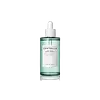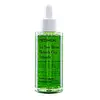What's inside
What's inside
 Key Ingredients
Key Ingredients

 Benefits
Benefits

 Concerns
Concerns

No concerns
 Ingredients Side-by-side
Ingredients Side-by-side

Centella Asiatica Extract 55%
CleansingChamaecyparis Obtusa Water
MaskingMelaleuca Alternifolia Leaf Water 9.4%
AntimicrobialPinus Palustris Leaf Extract
TonicGlycerin
HumectantButylene Glycol
HumectantMethyl Gluceth-20
HumectantDipropylene Glycol
HumectantGlycereth-26
Humectant1,2-Hexanediol
Skin ConditioningWater
Skin ConditioningHydroxyacetophenone
AntioxidantAmmonium Acryloyldimethyltaurate/Vp Copolymer
Propanediol
SolventPolyglyceryl-10 Laurate
Skin ConditioningEthylhexylglycerin
Skin ConditioningPentylene Glycol
Skin ConditioningCaprylyl Glycol
EmollientDisodium EDTA
Melaleuca Alternifolia Leaf Oil
AntioxidantOenothera Biennis Flower Extract
AstringentPueraria Lobata Root Extract
HumectantUlmus Davidiana Root Extract
Skin ConditioningCentella Asiatica Extract 55%, Chamaecyparis Obtusa Water, Melaleuca Alternifolia Leaf Water 9.4%, Pinus Palustris Leaf Extract, Glycerin, Butylene Glycol, Methyl Gluceth-20, Dipropylene Glycol, Glycereth-26, 1,2-Hexanediol, Water, Hydroxyacetophenone, Ammonium Acryloyldimethyltaurate/Vp Copolymer, Propanediol, Polyglyceryl-10 Laurate, Ethylhexylglycerin, Pentylene Glycol, Caprylyl Glycol, Disodium EDTA, Melaleuca Alternifolia Leaf Oil, Oenothera Biennis Flower Extract, Pueraria Lobata Root Extract, Ulmus Davidiana Root Extract
Melaleuca Alternifolia Leaf Water
AntimicrobialButylene Glycol
HumectantGlycerin
Humectant1,2-Hexanediol
Skin ConditioningDiethoxyethyl Succinate
SolventWater
Skin ConditioningCutibacterium Granulosum Ferment Extract Filtrate
EmollientCamellia Sinensis Leaf Extract
AntimicrobialMelia Azadirachta Leaf Extract
Skin ConditioningPolyglyceryl-10 Laurate
Skin ConditioningPolyglyceryl-10 Myristate
Skin ConditioningAcrylates/C10-30 Alkyl Acrylate Crosspolymer
Emulsion StabilisingArginine
MaskingMelia Azadirachta Flower Extract
Skin ConditioningEthylhexylglycerin
Skin ConditioningXylitylglucoside
HumectantSclerotium Gum
Emulsion StabilisingAnhydroxylitol
HumectantLecithin
EmollientXylitol
HumectantMaltodextrin
AbsorbentPentylene Glycol
Skin ConditioningHydrolyzed Acacia Macrostachya Seed Extract
Skin ConditioningPersea Gratissima Fruit Extract
EmollientGlucose
HumectantAsiaticoside
AntioxidantAsiatic Acid
Skin ConditioningMadecassic Acid
Skin ConditioningCentella Asiatica Extract
CleansingPolygonum Cuspidatum Root Extract
AntioxidantScutellaria Baicalensis Root Extract
AstringentSodium Hydroxide
BufferingTocopherol
AntioxidantGlycyrrhiza Glabra Root Extract
Bleaching4-Terpineol
MaskingMadecassoside
AntioxidantCaprylic/Capric Triglyceride
MaskingChamomilla Recutita Flower Extract
MaskingRosmarinus Officinalis Leaf Extract
AntimicrobialChaenomeles Sinensis Fruit Extract
AntioxidantCitrus Aurantium Dulcis Flower Extract
Skin ConditioningMelilotus Officinalis Extract
AstringentMedicago Sativa Extract
TonicTriticum Vulgare Germ Extract
Skin ConditioningBrassica Oleracea Italica Extract
AstringentBrassica Oleracea Capitata Leaf Extract
Skin ConditioningBrassica Campestris Extract
Skin ConditioningRaphanus Sativus Seed Extract
Skin ConditioningMelaleuca Alternifolia Leaf Water, Butylene Glycol, Glycerin, 1,2-Hexanediol, Diethoxyethyl Succinate, Water, Cutibacterium Granulosum Ferment Extract Filtrate, Camellia Sinensis Leaf Extract, Melia Azadirachta Leaf Extract, Polyglyceryl-10 Laurate, Polyglyceryl-10 Myristate, Acrylates/C10-30 Alkyl Acrylate Crosspolymer, Arginine, Melia Azadirachta Flower Extract, Ethylhexylglycerin, Xylitylglucoside, Sclerotium Gum, Anhydroxylitol, Lecithin, Xylitol, Maltodextrin, Pentylene Glycol, Hydrolyzed Acacia Macrostachya Seed Extract, Persea Gratissima Fruit Extract, Glucose, Asiaticoside, Asiatic Acid, Madecassic Acid, Centella Asiatica Extract, Polygonum Cuspidatum Root Extract, Scutellaria Baicalensis Root Extract, Sodium Hydroxide, Tocopherol, Glycyrrhiza Glabra Root Extract, 4-Terpineol, Madecassoside, Caprylic/Capric Triglyceride, Chamomilla Recutita Flower Extract, Rosmarinus Officinalis Leaf Extract, Chaenomeles Sinensis Fruit Extract, Citrus Aurantium Dulcis Flower Extract, Melilotus Officinalis Extract, Medicago Sativa Extract, Triticum Vulgare Germ Extract, Brassica Oleracea Italica Extract, Brassica Oleracea Capitata Leaf Extract, Brassica Campestris Extract, Raphanus Sativus Seed Extract
 Reviews
Reviews

Ingredients Explained
These ingredients are found in both products.
Ingredients higher up in an ingredient list are typically present in a larger amount.
1,2-Hexanediol is a synthetic liquid and another multi-functional powerhouse.
It is a:
- Humectant, drawing moisture into the skin
- Emollient, helping to soften skin
- Solvent, dispersing and stabilizing formulas
- Preservative booster, enhancing the antimicrobial activity of other preservatives
Butylene Glycol (or BG) is used within cosmetic products for a few different reasons:
Overall, Butylene Glycol is a safe and well-rounded ingredient that works well with other ingredients.
Though this ingredient works well with most skin types, some people with sensitive skin may experience a reaction such as allergic rashes, closed comedones, or itchiness.
Learn more about Butylene GlycolCentella Asiatica Extract (Centella) is derived from an herb native to Southeast Asia. It is famous for its anti-inflammatory and soothing properties.
Centella is rich in antioxidants and amino acids, such as Madecassic Acid and Asiaticoside.
Studies show the compounds in centella help with:
The combination of all these properties makes centella effective at soothing, hydrating, and protecting the skin.
Other great components of centella include Vitamin A, vitamin C, several B vitamins, and Asiatic Acid.
Fun fact: Centella has been used as a medicine and in food for many centuries. As a medicine, it is used to treat burns, scratches, and wounds.
Learn more about Centella Asiatica ExtractEthylhexylglycerin (we can't pronounce this either) is commonly used as a preservative and skin softener. It is derived from glyceryl.
You might see Ethylhexylglycerin often paired with other preservatives such as phenoxyethanol. Ethylhexylglycerin has been found to increase the effectiveness of these other preservatives.
Glycerin is already naturally found in your skin. It helps moisturize and protect your skin.
A study from 2016 found glycerin to be more effective as a humectant than AHAs and hyaluronic acid.
As a humectant, it helps the skin stay hydrated by pulling moisture to your skin. The low molecular weight of glycerin allows it to pull moisture into the deeper layers of your skin.
Hydrated skin improves your skin barrier; Your skin barrier helps protect against irritants and bacteria.
Glycerin has also been found to have antimicrobial and antiviral properties. Due to these properties, glycerin is often used in wound and burn treatments.
In cosmetics, glycerin is usually derived from plants such as soybean or palm. However, it can also be sourced from animals, such as tallow or animal fat.
This ingredient is organic, colorless, odorless, and non-toxic.
Glycerin is the name for this ingredient in American English. British English uses Glycerol/Glycerine.
Learn more about GlycerinThis ingredient is created by distilling parts of the tea tree plant. The bark and leaves of the tea tree plant are rich in Terpinen, an antioxidant, antibacterial, and anti-inflammatory ingredient.
Tea tree may cause sensitivity and irritation for some people due to its linalool and limonene content.
Learn more about tea tree benefits here.
Learn more about Melaleuca Alternifolia Leaf WaterPentylene glycol is typically used within a product to thicken it. It also adds a smooth, soft, and moisturizing feel to the product. It is naturally found in plants such as sugar beets.
The hydrophilic trait of Pentylene Glycol makes it a humectant. As a humectant, Pentylene Glycol helps draw moisture from the air to your skin. This can help keep your skin hydrated.
This property also makes Pentylene Glycol a great texture enhancer. It can also help thicken or stabilize a product.
Pentylene Glycol also acts as a mild preservative and helps to keep a product microbe-free.
Some people may experience mild eye and skin irritation from Pentylene Glycol. We always recommend speaking with a professional about using this ingredient in your routine.
Pentylene Glycol has a low molecular weight and is part of the 1,2-glycol family.
Learn more about Pentylene GlycolPolyglyceryl-10 Laurate is an ester of lauric acid and Polyglycerin-10.
Polyglyceryl-10 Laurate is a cleansing agent and emulsifier. It helps gather dirt, oil, and other pollutants to be rinsed away. As an emulsifier, it helps prevent ingredients from separating, such as oil and water.
Polyglyceryl-10 Laurate may not be fungal acne safe.
Learn more about Polyglyceryl-10 LaurateWater. It's the most common cosmetic ingredient of all. You'll usually see it at the top of ingredient lists, meaning that it makes up the largest part of the product.
So why is it so popular? Water most often acts as a solvent - this means that it helps dissolve other ingredients into the formulation.
You'll also recognize water as that liquid we all need to stay alive. If you see this, drink a glass of water. Stay hydrated!
Learn more about Water